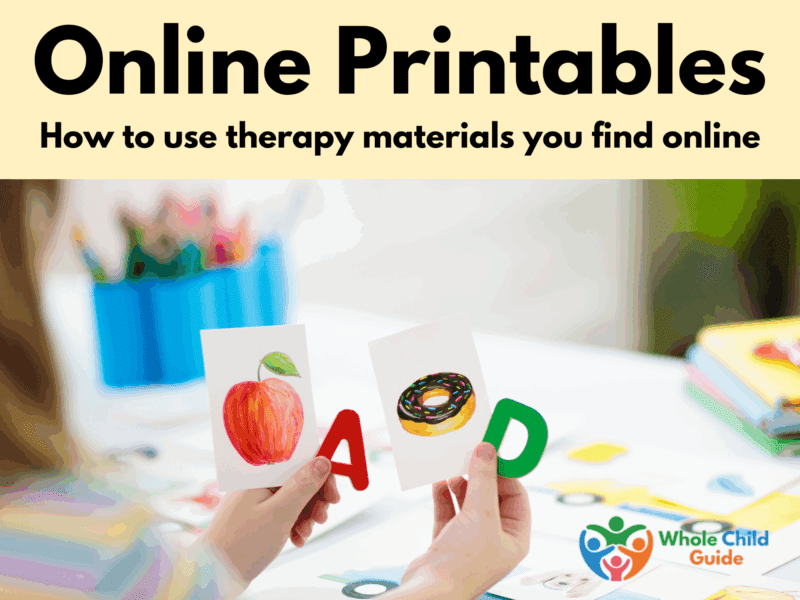
If you’ve run a search online about meeting your child’s needs? You’ve probably run across digital materials that are available as downloads or as purchases. You buy the e-book or the worksheet set and you’ve got a digital set of resources you can print off and use to help your child’s development. But how do you know what is right for your child’s needs? And then after you print off those activity sheets, what next?
In today’s digital world, printable therapy materials are everywhere, and for good reason. They’re affordable, accessible, and easy to use for both parents supporting their children at home and professionals working in schools, clinics, or private practice. Whether you’re printing a handwriting worksheet, visual schedule, or sensory activity board, these resources can be powerful tools when used correctly.
But with so many downloads floating around the internet, it’s important to understand not just how to use them, but how to use them responsibly. In this guide, we’ll walk through what printable therapy materials are, how they can support development, what copyright rules to follow, and how to find high-quality resources that match your specific goals, using trusted tools like Whole Child Guide.
Who Uses Printable Therapy Materials, and Why
As an occupational therapist, I know that printable therapy materials are used by therapy professionals as motivating therapy interventions. But the cool thing is that parents can also use printable materials to support children’s development, learning, and daily functioning. They’re accessible, customizable, and can be easily adapted to meet a child’s specific needs. This means worksheets or activity sheets are a favorite tool in both home and clinical environments.
Parents often turn to printable resources when they want to provide extra support at home, reinforce skills their child is working on in therapy, or create structure in their daily routine. Online resources might be a visual schedule to help with transitions, a calm-down chart for emotional regulation, or a fine motor activity for building hand strength. These printables offer practical, screen-free ways to connect with their child and support skill development.
Therapists, educators, and child development professionals use printable materials to supplement their sessions with engaging, low-prep activities that are both fun and functional. These resources are ideal for individual therapy, group sessions, or home programs, and allow providers to personalize interventions for each child.
For example, an occupational therapist might use printable cutting lines or pencil control worksheets, while a speech therapist may use articulation cards or visual supports for communication.
What makes printable resources so valuable is their flexibility. They can be used across a wide range of settings like at the kitchen table, in the therapy room, in a classroom, or even outdoors. For families and professionals alike, they offer a simple but powerful way to work on real-life goals in developmentally appropriate, child-centered ways.
Parents often turn to printables to help their child at home with:
- Sensory regulation
- Emotional awareness
- Fine motor development
- Executive functioning
- Academic support (like letter formation or visual schedules)
Therapists and educators use printables to:
- Support therapy sessions with hands-on, engaging tools
- Provide carryover materials for home practice
- Reinforce targeted skills like behavior, communication, or coordination
- Customize learning or intervention based on individual needs
Printable resources can save time, provide structure, and offer fun, developmentally appropriate ways to work on meaningful goals.
How to Find Materials That Fit Your Child or Clients’ Needs
Not every printable will be the right fit for every child. When searching for resources:
- Think developmentally, not just by age. A 4-year-old and a 6-year-old might benefit from the same emotional regulation chart, depending on their skills.
- Search by skill area or goal, such as “fine motor,” “sensory processing,” “visual schedules,” or “social stories.”
- Look for downloads created by professionals (like OTs, speech therapists, or counselors) who understand how to make resources that are developmentally appropriate and evidence-informed.
- Preview materials when possible—does the tone fit your child? Is it simple, visual, engaging, and flexible?
Tips for Printing, Organizing, and Reusing Your Resources
- Print in color when visuals matter (e.g., emotion faces or visual schedules).
- Use sheet protectors or laminate resources you’ll use repeatedly.
- Store by skill area in labeled binders, file folders, or clear plastic bins.
- For therapists: Keep a mobile cart or grab-and-go folder for rotating materials.
- Use Velcro dots or dry-erase markers to make printables interactive.
Common Questions About Printable Resources
Can I share a printable with another parent or therapist?
Yes, but only by sharing the link to the original site or shop, not the actual file.
Can I use it with all of my clients or students?
Yes, as long as it’s for direct use in your sessions. You cannot include it in a product, class, or training without permission.
Can I post it in a parent group online?
Only if you link to the original creator’s site. Do not upload the file itself.
Can I use printables in a commercial resource I’m creating?
Not unless you’ve purchased a commercial license or received permission from the creator.
Use Whole Child Guide to Find Printable Resources That Work for You
Whether you’re a parent or a professional, Whole Child Guide is your go-to tool for finding trusted digital content creators who specialize in child development resources.
We’ve made it easy to search by:
- Type of professional (OT, SLP, educator, counselor)
- Skill area (fine motor, emotional regulation, sensory, behavior)
- Type of resource (visual schedules, worksheets, games, printables)
- Delivery method (digital downloads, print-and-go, activity kits)
You can even filter by state-licensed providers if you’re also looking for therapy services, ensuring that your child’s support is rooted in professional guidance and tailored tools.
What next?
Printable therapy resources are a fantastic way to support your child or clients—at home, in the clinic, or in the classroom. Just remember: behind every great download is a creator who took the time to design it with care and expertise.
Support their work by using materials as intended and sharing their links, not their files.
Ready to find printable resources that actually fit your needs?
Explore Whole Child Guide to discover therapy providers, educators, and digital content creators who offer downloadable tools you can trust—because your child deserves support that’s thoughtful, evidence-based, and easy to access.
